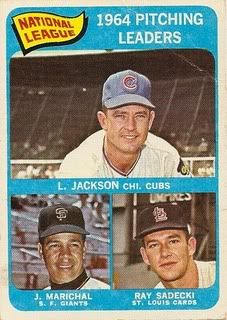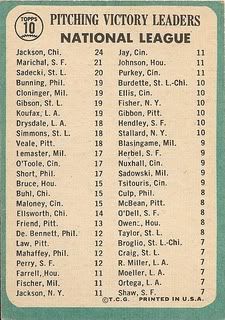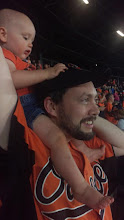
For some reason, Topps always used to label the league leaders in wins as "pitching leaders". Seems needlessly vague. In this case, the winningest pitcher in the National League, and in all of the major leagues, was righthanded veteran Larry Jackson of the Cubs. He posted a 24-11 record for a Chicago team that won just 76 games all season, making him responsible for nearly a third of all of their victories. But it wasn't enough to earn him the Cy Young Award; only one trophy was given out for the entire MLB in 1964, and it went to Dean Chance of the Angels. The young Los Angeles pitcher was 20-9 with a 1.65 ERA that was nearly half of Jackson's 3.14 mark. I'm sure it didn't put much of a damper on a career year for the Cubbie ace, whose second-highest win total in a 14-year career was 18. He finished strong in 1964, reeling off 9 straight W's from August 22 through September 27 to boost his record from 14-10 to 23-10 before splitting his final two decisions of the year. He might have had an even better season if he didn't call breezy Wrigley Field home: Larry was 10-6 with a 3.83 ERA at home and 14-5 with a 2.55 mark on the road. A little run support never hurts, either. The Cubbies scored 6 runs or more in 11 of Jackson's starts in 1964, and he had 10 wins and a single no-decision in those games. He also won the games he was expected to, posting an overall 9-0 mark against the young Colt .45s and Mets.
The runner-up in 1964 was another right-hander, but that's where the similarities end. Juan Marichal was 21-8 that year for the Giants, one of six times that he topped 20 wins in a season. He had topped the loop with 25 W's in 1963, and would do it again with 26 in 1968. He posted a sparkling 2.48 ERA and led the league with 22 complete games, yet got no votes for Cy Young. If that happened today, we'd never hear the end of it! He averaged 8.75 innings pitched per start in September and October, going 8 strong innings in the only game he did not finish. (There was also an 8-inning CG road loss.) He only made one start in August, which held down his win total, but came back with that great September/October (6-2, 2.19 ERA). He was a Colt and Dodger killer, winning four apiece against those two clubs.
Cardinals southpaw Ray Sadecki was already in his fifth big league season in 1964 when he went 20-11 with a 3.68 ERA at age 23. He would hang around for 13 more, but never had more than a dozen victories in any subsequent season. He had the dubious honor of leading the N.L. with 18 losses for a second-place Giants squad in 1968, and was a swingman and eventually a full-time reliever as his career progressed. Coincidentally, Ray won exactly four games in every month of the 1964 campaign except for April, when he lost his only start. He did the most damage against the Phillies, with a 4-1 record and a 1.91 ERA in four starts against Gene Mauch's men. Sadecki added a 21st win in Game 1 of the World Series, allowing four Yankee runs in six innings and benefiting from a St. Louis offense that hit Whitey Ford even harder.
The expanded leaderboard on the back gives a full rundown all the way down to seven wins. You'll notice that three Hall of Famers (Jim Bunning, Bob Gibson, and Sandy Koufax) just missed the big 2-0, with Tony Cloninger joining them as an oddball. Every team had at least a single 15-game winner with the exception of (who else?) the Mets, whose top W-man was Al Jackson with his gaudy 11-16 mark. Notably absent is Warren Spahn, who went 6-13 with an ugly 5.29 ERA at age 43. It was his last season with the Braves, and the first since 1946 (when he went 8-5 in 24 gamesin which he failed to post at least 14 victories. But we'll deal more with him later.



No comments:
Post a Comment